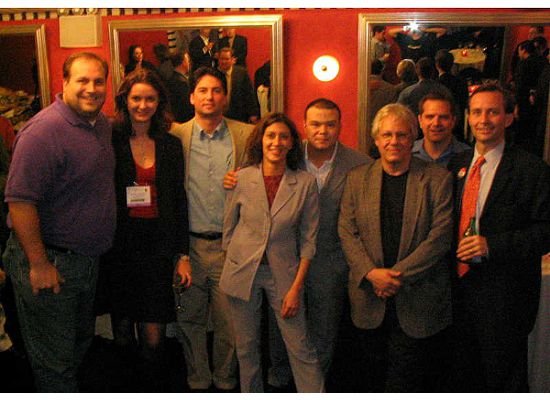Self Deception: Broadcasting Works Better Than Dialogue
/I’m very proud of a campaign I once designed that involved consumers of a particular brand in a conversation. At an agency I once worked for, we designed online ads that sought permission to send fans of this brand a regular newsletter chock full of brand lore, games and all sorts of other opportunities for further engagement. It essentially involved consumers in a two-way conversation, managed by CRM software, which gave them a brand community around which to rally. Online ads performed the acquisition function and CRM software allowed us to use e-mail to manage the conversation. I’ve never seen such devotion to a brand come out of an online marketing campaign. As part of one of the newsletters, we provided a link to a game that featured the brand prominently. A technical glitch disabled the game after a certain period of time, and we were swamped with complaints from people who loved it and wanted us to put it back up, so we did.
We also received (unsolicited, mind you) stories from participants in the program concerning their history with the brand and why they loved it so much. We shared these stories with the client when they came in.
The program, however, was canceled. Originally, it was designed to reach the brand’s core target (older folks). When the program surged in popularity and began to attract a younger audience, the client deemed it ineffective at addressing the core target. My team protested that there was no need to deny younger folks the ability to participate and highlighted the value of the program – generating loyalty, favorability and a forum for the brand. Despite marked increases (via a series of online surveys) in brand favorability and loyalty, the program was strangled in its cradle and taken off the Internet. The e-mail addresses, contact information and interaction data gleaned from the program were all left to rot in a database somewhere. The thing that kills me about this is that conversation development is one of the Internet’s great strengths, but many marketers don’t see development of conversations as an asset. Instead, they see it as a threat – something that can grow outside their realm of control and outside their ability to address it. This simply has to change if Internet marketing is going to become a cornerstone of marketing strategy.
Let me offer up an example of a company that does it right. In 1996, I purchased a signal processor for my guitar made by a company called DigiTech. The processor was quite difficult to understand fully, so one of the things I did upon acquiring it was check the Internet for resources that would help me understand how best to use it and understand its capabilities. I found that an online community had sprung up organically around this product – DigiTech’s GSP-2101. The GSP Users Forum had been started by a GSP owner named Steve Schow, who had no official affiliation with DigiTech whatsoever, and the community consisted of an e-mail discussion list and a few web pages where people could share the programs they had developed for the processor.
Over time, the community grew in size and attracted the attention of a gentleman in DigiTech’s marketing department named Randy Thorderson, who had helped develop the GSP-2101. Randy had the foresight and the presence of mind to see the GSP Users Forum for what it truly was – an opportunity. In the days when corporations were routinely shutting down fan sites and unauthorized web sites, Randy instead chose to become a member of the community. He joined the list and served as DigiTech’s official representative to the community, answering questions about the product, sharing his own ideas and taking suggestions for the next iteration of the product.
While Randy was certainly flamed many times on the list for what some list members thought were flaws in the product, he eventually helped cultivate a positive experience both for DigiTech and GSP owners. When the next version of the product came out, he let the community know how their suggestions had helped to shape it. He shared custom programs for the processor that he had created in his spare time. Generally, list members saw the community as a great asset and DigiTech was able to cultivate loyalty, get some great new product ideas, and even use the group as a sort of informal focus group.
Randy was not afraid of the conversation. After spending some time with the community, his efforts were rewarded by DigiTech and he was promoted within his department. When I see Randy’s shining example of how to market online via consumer conversations, I can’t help but wonder why others in similar positions within their product marketing groups can’t see these conversations as assets.
Looking at the way many companies market online, I see four main attributes that help delineate between companies that embrace the community/conversation approach and those that don’t:
1) Ability to Recognize Communities and Conversations as Assets – Either you see it or you don’t. Some marketing professionals react to a fan website by immediately going to the legal department and issuing a nasty letter. Others see devotion to a brand as something that ought to be cultivated, and they take a markedly different approach. It’s this second type of marketing professional that can learn to use the Internet as a marketing vehicle appropriately.
2) Transparency – Some companies want to be transparent to their customers and have them play a participatory role in the direction of the brand and the products under that brand. Other companies want to keep things very close to the vest. It is the company that falls into the former category that cultivates brand loyalty and long-term success.
3) Tolerance for the Chaos Factor of Online Conversations – The biggest chance a company takes when embracing brand conversations is that they could grow beyond control. There are several ways this can happen. The sheer number of online users participating can grow to an unmanageable size quickly, online users can demand things that companies are unprepared to give, or a marketing professional could find his or her time dominated by the need to participate in these discussions. While all are legitimate concerns, the company that succeeds usually finds a way to facilitate rather than clamp down. The truth is that the conversations are going to occur one way or another. Wouldn’t a company want to participate and help shape the discussion, rather than ignore it and thus ignore the opportunity?
4) Devotion to Strategies Other than the Mass Market Approach – Some companies look for ways other than the mass dissemination of sales messages to help market their product. Others are focused on the numbers game – the highest number of customer acquisition or sales messages disseminated to the largest number of people in the target audience. The willingness to see a different approach and concentrate on the lifetime value of a loyal customer are what separates the successful from the unsuccessful.
The truth of the matter is that conversations about brands and products are going to occur whether or not the company behind those brands and products participates. The companies themselves can provide forums, or they can be lazy non-participants and let communities spring up on their own. How many companies have had to deal with BrandXSucks websites springing up like mushrooms? Or a rash of negative feedback on consumer review sites like Epinions? How many Yahoo! Groups, independent message boards and other low- or no-cost forums have sprung up to discuss products, regardless of what the company producing the product does or says?
How many of the negative comments that are posted to these forums could be easily addressed by having a liaison to the company present to answer questions and solve problems? Dedicating such a resource is a credit to the company in and of itself, because it demonstrates a willingness to listen and invest in the conversation.
Steve Hall from AdRants once picked up on one of my Online Spin articles and wrote the following, which I heartily agree with:
Hespos also discusses what really amounts to fear and laziness on the marketer's part to engage with the consumer in a meaningful conversation and suggest the creation of simple brand-hosted message boards and discussion lists the draw consumers into a conversation about a company's product. Certainly, bad things will be said about any given product but wouldn't a smart marketer want to know everything about their product including what might be wrong with it?
I'd go a step further and suggest the creation of an entirely new discipline headed by a director of customer/consumer conversation/dialog. The sole responsibility if this person/department would be to converse and listen to the consumers with no interest in selling product. Sure, product management, marketing, sales and customer service touch this area but not enough to make it effective. Each of those disciplines has a goal that is counter to having an open, honest and friendly discussion with a customer or prospective consumer.
He closed his post with the following statement:
Give a shit. Basically, that's what this boils down to. Consumers are not a vast collection of numbers on a spreadsheet or a nice collection of 5 categories with silly marketing names like "early, suburban adopter." They are people with real concerns that will, ultimately, lead to a better product. Listen and give a shit. That's good marketing medicine.
To Steve’s thoughts, I’d like to add the following…
The conversation is not to be controlled, stifled or led astray with dishonesty. Consumers, particularly the ones participating in the conversation, have finely-tuned BS detectors that will pick up on any such attempts and they’ll move the conversation elsewhere. Instead, a consumer conversation effort should aim to represent the company’s brand, products and ideals in a transparent way. It should answer whatever questions are asked – truthfully or not at all. It should move the conversation forward, taking constructive criticism and acknowledging it for what it is – not just a suggestion for how to improve, but an investment in the brand of time and thought on the part of the consumer. At the very least, such investments need to be acknowledged. At best, they help shape brands and products by providing new ideas and insight – and the consumer becomes more loyal as he realizes his insights are taken to heart.
The billions upon billions of ad impressions served online can be conversation starters. Only a small fraction of them truly are. And that is where the self-deception lies. We kid ourselves when we fail to see the true value behind our outreach to audiences on the Internet. We think of online advertising solely as a way to extend reach to audiences we might not reach through other media, or as ways to get potential customers to click and buy. While there certainly is value there, failure to recognize that markets are conversations is just another instance of self-deception. If we are to fully recognize the value of online marketing, we need to stop kidding ourselves in this manner.












































